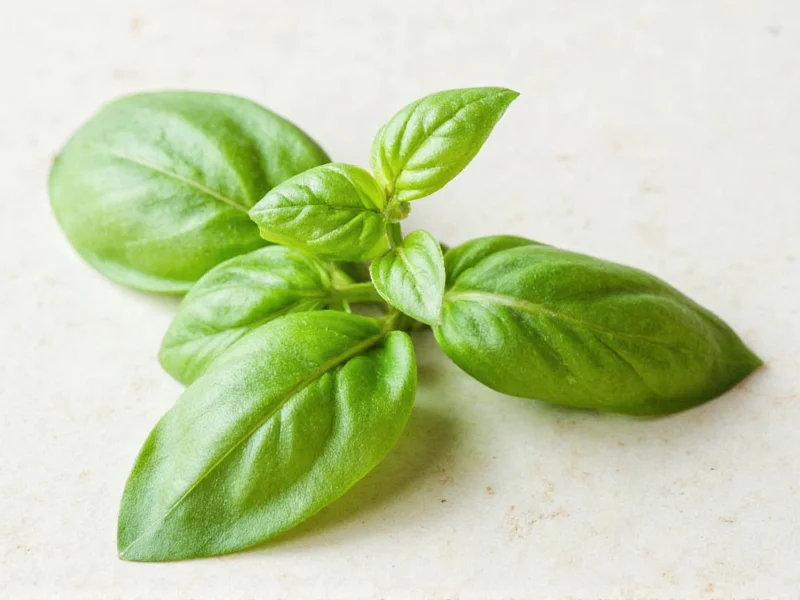2 tablespoons of fresh basil equals 2/3 tablespoon (or 2 teaspoons) of dried basil. This 3:1 conversion ratio accounts for dried basil's concentrated flavor due to moisture loss during the drying process. Always adjust to taste as herb potency varies based on freshness and storage conditions.
When adapting recipes, understanding herb conversions prevents flavor imbalances that can ruin your dish. The difference between fresh and dried basil stems from their moisture content—fresh basil is about 90% water, while dried basil loses this moisture, concentrating its essential oils and flavor compounds. This scientific principle explains why you need less dried basil to achieve similar flavor intensity.
The Science Behind Herb Potency
Herb drying removes moisture but preserves flavor compounds, creating a more potent product by volume. Fresh basil contains volatile oils that provide its characteristic aroma, but these become more concentrated as water evaporates during drying. Food science research shows dried herbs typically contain 2-3 times the flavor compounds per unit weight compared to fresh counterparts.
This concentration effect varies by herb type. Basil experiences moderate concentration (about 3:1), while more delicate herbs like cilantro show greater potency changes. The drying method also impacts final potency—sun-dried herbs often retain more flavor than oven-dried varieties due to gentler processing.
Standard Conversion Guidelines
The universally accepted culinary standard uses a 3:1 ratio for fresh-to-dried herb conversion. This means for every 3 parts fresh herb, you need 1 part dried herb. Here's how this applies specifically to basil measurements:
| Fresh Basil | Dried Basil Equivalent | Practical Measurement |
|---|---|---|
| 1 teaspoon | 1/3 teaspoon | Just a pinch |
| 1 tablespoon | 1 teaspoon | Standard measuring spoon |
| 2 tablespoons | 2/3 tablespoon | 2 teaspoons |
| 1/4 cup | 1.33 tablespoons | 1 tablespoon + 1 teaspoon |
| 1/2 cup | 2.66 tablespoons | 2 tablespoons + 2 teaspoons |
Practical Substitution Techniques
Successful herb substitution requires more than simple measurement conversion. Consider these professional kitchen techniques:
- Timing matters: Add dried basil early in cooking to allow rehydration and flavor dispersion, while fresh basil should be added near the end to preserve volatile oils
- Rehydration trick: For sauces and soups, briefly soak dried basil in warm broth or oil before adding to improve flavor release
- Taste testing: Always taste after adding 75% of the calculated amount, then adjust incrementally—dried herbs can vary significantly in potency
- Flavor profile adjustment: Recognize that dried basil develops earthier notes while fresh basil offers brighter, grassier flavors—you may want to supplement with a pinch of oregano when substituting
Avoiding Common Substitution Mistakes
Many home cooks make critical errors when converting between fresh and dried basil. The most frequent issues include:
- Over-substitution: Using equal measurements instead of adjusting for concentration, resulting in overpowering, bitter dishes
- Incorrect timing: Adding dried herbs too late in cooking, preventing proper flavor development
- Ignoring freshness factors: Not accounting for dried herb age—basically, dried herbs lose 30% of potency annually when improperly stored
- Texture neglect: Failing to consider how dried herb particles affect dish texture, particularly problematic in delicate sauces
Professional chefs recommend storing dried basil in airtight containers away from light and heat. Properly stored, it maintains optimal flavor for 1-2 years. Test older dried herbs by rubbing between fingers—if little aroma releases, replace with fresh stock. For critical dishes, consider making your own dried basil using a food dehydrator at 95°F (35°C) for 8-12 hours to preserve maximum flavor compounds.
When Substitution Isn't Ideal
Certain dishes simply don't translate well with herb substitutions. Caprese salad, fresh pesto, and bruschetta rely on fresh basil's vibrant flavor and texture that dried basil cannot replicate. Conversely, long-simmered tomato sauces, stews, and braises often benefit from dried basil's concentrated flavor that withstands extended cooking.
Understanding these culinary principles transforms your herb substitution from a guessing game into a precise technique. Whether you're adapting a family recipe or experimenting with new flavors, proper basil conversion ensures balanced, professional-quality results every time. Remember that personal taste preferences ultimately guide final seasoning—these ratios provide a reliable starting point that you can adjust to your palate.
Can I substitute dried basil for fresh in pesto?
No, dried basil doesn't work well in traditional pesto. The fresh herb's vibrant flavor and texture are essential to authentic pesto. Dried basil lacks the necessary oils and moisture, resulting in a bitter, dusty paste. For pesto, always use fresh basil for best results.
Why does my dish taste bitter after substituting dried basil?
Bitterness typically occurs when using too much dried basil. Remember the 3:1 conversion ratio—2 tablespoons fresh equals only 2 teaspoons dried. Dried herbs are more concentrated, so exceeding proper measurements creates overpowering, bitter flavors. Always start with less and adjust gradually.
How do I adjust cooking time when using dried basil instead of fresh?
Add dried basil early in the cooking process (15-20 minutes before completion) to allow rehydration and flavor development. Fresh basil should be added in the last 2-3 minutes of cooking to preserve its delicate flavor compounds and vibrant color.
Does the conversion ratio differ for other herbs?
Yes, conversion ratios vary by herb. Delicate herbs like cilantro and parsley follow the standard 3:1 ratio. Stronger herbs like rosemary and thyme use a 4:1 ratio (4 parts fresh to 1 part dried). Always research specific herb conversions for best results in your recipes.
Can I make my own dried basil at home?
Yes, home-drying preserves more flavor than store-bought dried basil. Wash fresh leaves, pat dry, and hang in small bundles in a dark, well-ventilated area for 1-2 weeks. Alternatively, use a food dehydrator at 95°F (35°C) for 8-12 hours. Store in airtight containers away from light for maximum shelf life.











 浙公网安备
33010002000092号
浙公网安备
33010002000092号 浙B2-20120091-4
浙B2-20120091-4